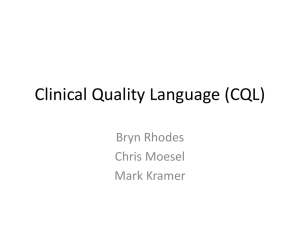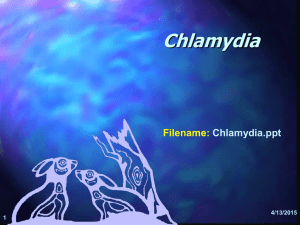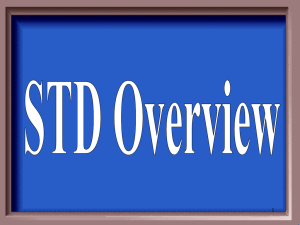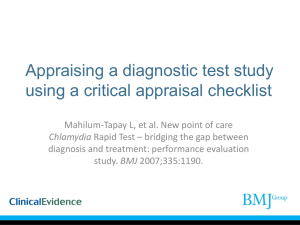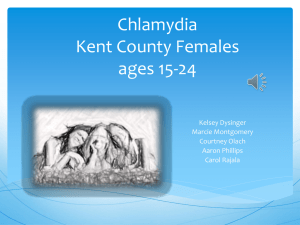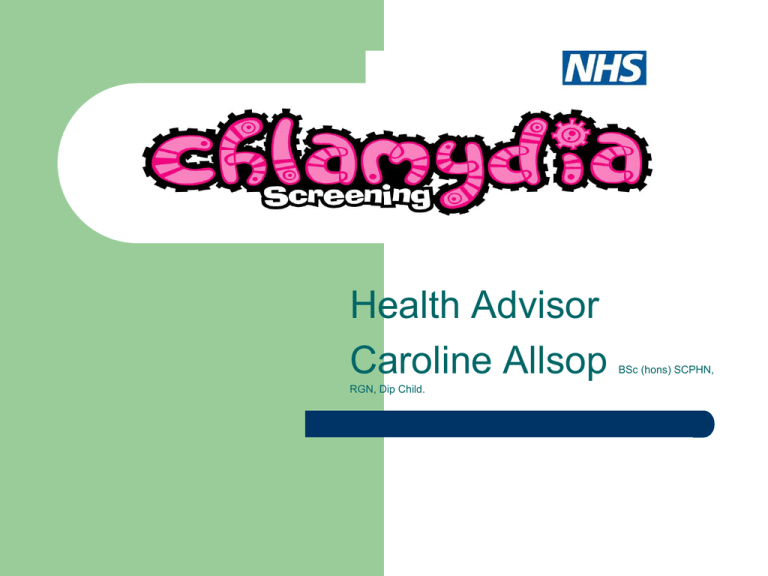
Health Advisor
Caroline Allsop
RGN, Dip Child.
BSc (hons) SCPHN,
Agenda
Aim of the NCSP
What is Chlamydia/history
Transmission
Symptoms
Complications of untreated chlamydia
Screening process and resources/ new venue info
Results
Central Office Function
Reading list
Contact details
Exclusions within this training
Other sexually transmitted infections
Behaviour change
Sexual Health Policies
Safeguarding
Fraser competencies
What is the message
Chlamydia is Invisible
Chlamydia is Serious
Chlamydia is Spreading
Opportunistic, Asymptomatic
Programme
AIM: National Chlamydia Screening
Programme
To control Chlamydia through the early
detection and treatment of
asymptomatic infection; to prevent the
development of sequelae; and to
reduce the onward disease
transmission
GUM and Chlamydia Screening
statistics 2010 (HPA 2011)
Health Protection Agency (HPA) reveal that as part of an overall rise in
bacterial STI’s Chlamydia is now the most commonly diagnosed infection in
England, Wales and Northern Island.
The peak age for an STI in men is 20-23 years.
The peak age for an STI in women is between 19-20 years.
Studies have shown that young adults are more likely to have unsafe sex and
often lack the skills and confidence to negotiate safer sex.
In 2010, 65% of people with Chlamydia were under 25 years old
217,570 new cases seen in GUM clinics in 2010 reflect an increase of 8% in
women and 5% in men over the previous year
History of Chlamydia
1909 - Chlamydia was recognised as the source of
infection in neonates and adults with eye infections
(Westcott).
1911 - Recognised as an organism that could infect
the cervix in women and urethra in men (Westcott).
1950’s and early 1960’s that scientist discovered the
magnitude of the problem (Westcott).
1980’s - Advances in diagnostic testing lead to
cheaper, more sensitive and specific tests which
helped aid epidemiological and sequale research
studies (Moss).
What is Chlamydia?
Chlamydia Trachomatis is a bacterial infection. It is
unique and different to all other micro-organisms as
it requires a host cell to multiply.
Chlamydia is the most common STI in young people
75% of women and 50% of men have no symptoms
Anyone of any age can get Chlamydia.
It effects both men and women, regardless of lifetime
partners. You are at risk of catching chlamydia
regardless of your sexual orientation
Risk factors for STIs
Younger age (especially <20 years)
2 or more partners in preceding 6 months
Use of non barrier contraception
Living in inner city
Partner with symptoms
Having current STI
History of STI in the past
Sexual orientation
Ethnicity (for some STIs)
Percentage of STIs diagnosed in under 25 age
group in 2010
70
60
50
40
30
20
10
0
Chlamydia
GC
Herpes
Warts
Transmission
The most common way for people to become infected with Chlamydia is
through unprotected vaginal or anal sex with an infected person (HPA 2010)
Transmission can occur during:
vaginal sexual intercourse
anal sexual intercourse
oral-genital contact
mutual touching of genitals
sharing of sex toys
Genital Chlamydia infections may facilitate increased risk of HIV
transmission
Condoms should be used to minimise risk of sexual transmission
Chlamydia can also be vertically transmitted – passed to baby during birth –
which may result in neo-natal conjunctivitis or pneumonia, low birth weight
baby or miscarriage
Symptoms of chlamydia in
women
Most people do not have symptoms but if they do, these are
what they might be:
A vaginal discharge that is different to usual
The need to pee more often
Pain and /or burning when passing urine
Pelvic or lower abdominal pain
Irregular bleeding between periods or after sexual
intercourse
Pain during sexual intercourse
Joint pain
Conjunctivitis
Consequences of Chlamydia infection
in females (Q6)
In females, chlamydia initially infects the cervix and the urethra
where it can cause cervicitis (inflammation of the cervix) and
urethritis (inflammation of the urethra).
From the cervix, the bacteria can ascend to the upper genital tract
where it may cause pelvic inflammatory disease (PID), with or
without symptoms e.g. pelvic pain. It has been estimated that 1020 per cent of untreated infections result in PID.
Inflammation of the fallopian tubes associated with PID can cause
damage (e.g. fibrosis and scarring) that may result in future
ectopic pregnancy and/or tubal-factor infertility.
Consequences of Chlamydia infection
in females
Other sequelae of chlamydia in females though very rare include
Reiter’s syndrome (reactive arthritis) and Fitz-Hugh Curtis
syndrome (also known as perihepatitis [inflammation of the lining
of the liver]).
It is possible to be infected with chlamydia more than once,
particularly if a sexual partner remains infected (i.e. is not
tested/treated).
The risk of complications increases with repeated untreated
infections.
Pregnancy
Post partum endometritis occurs in 30% of women
with antenatal Chlamydia infection. If unrecognised
and untreated secondary infertility may result.
Infants with mothers with Chlamydia infection will
develop conjunctivitis in 18 – 50 % of cases.
Pneumonia can occur in 11 – 20 % of cases which
may lead to severe respiratory failure with some
evidence to suggest long term respiratory disease
may occur.
Reference
Moss, T. R. (2006), International Handbook of
Chlamydia 2nd Addition.
Symptoms of chlamydia in men
Most people do not have symptoms but if they do, these are
what they might be:
A discharge from the tip of the penis (Q5)
Pain and/or burning when peeing
Irritation at the top of the penis
Painful swelling of the testicles
Consequences of Chlamydia infection
in males (Q6)
Urethritis
Epididymitis (inflammation of the epididymis [a coiled segment
of the spermatic ducts])
Prostatis (inflammation of the prostate gland)
Proctitis (rectal inflammation)
Reiter’s syndrome.
Infertility
Conjunctivitis
Treatment for chlamydia infection is highly effective and
reduces the risk of complications.
Those with symptoms
Recommended a full screen for those who report symptoms
Advise that symptoms may be due to other STI’s
and refer to service offering full STI screen
However
Due to risk of loss to follow up:
Screen and refer
Inclusion - Criteria for Screening
Asymptomatic male or female aged 15-24yrs who are
sexually active and live in Newcastle, Northumberland or
North Tyneside.
Have never been screened for chlamydia before
Recommend an annual screen
Changed their sexual partner (test 2 weeks after sexual
contact)
Health Advisors test and give epidemiological treatment to All
sexual partners regardless of age
Exclude…
Those not living in Newcastle,Northumberland and North Tyneside.
Women and men 25 years old or older or under 15years.
Those who are not deemed competent to give their informed
consent. Under 16’s have to be assessed as Fraser Competent by
the test initiator. DH policy – “If Fraser Assessment is Law
and a DH requirement then it must be carried out” (Paula
Baraister the Medical Advisor for the NCSP)
Women and men who have been treated for chlamydia in the
previous 5 weeks (It is advised not to repeat a test within 5
weeks following completion of treatment for a positive result,
as the test may still detect residual chlamydia nucleic acids from
non viable organisms and give a false positive result.
Women and men who decline the offer of chlamydia screening
Swabs or Urine for Women?
Scottish Intercollegiate Guidelines Network (SIGN 2009) reviewed the
literature and found:
There is little difference in the results of vaginal and endocervical
swabs.
No significant difference in sensitivity between first catch urine
specimens and vaginal swabs.
The National Audit Office (NAO 2009) reported 67% of tests from
2008/2009 were urine samples.
SIGN (2009) concluded that women not undergoing a
speculum examination should be offered self vaginal
swabs or first void urine as both are acceptable.
Taking Samples
Client to complete form/label on specimen
Advise they take form and urine bottle/swab to toilet
(recommended not to have passed urine for 1 hour
and first void of urine required).
Advise when sample taken for client to ensure lid is
on secure and put into plastic bag at the back of the
form (if postal put sample into transporter first)
Advise client to remove strip and fold over to seal
bag.
Ask client to drop into specimen collection bag or put
into envelope to post to lab.
How to complete test form
Chlamydia Treatment
Treatment is provided by the CSO, however this is not always
acceptable to the client who may choose to go to GUM or their
GP.
Azithromycin 1g stat (Can be given in pregnancy)
Doxycycline 100mg for 7 days
Erythromycin 500mg for 14 days if patient pregnant
or unable to rule out pregnancy – repeat test 5
weeks after completing treatment
Advise no Sexual Contact for 7 days after treatment
completed (not even with a condom) or until partner
treated
Results (given by preferred method of contact usually within 7
days).
Negative results (asymptomatic) - text, phone, letter
Negative results (symptomatic) – as above but
advised to go to GUM or GP for full screening.
Positive Result (asymptomatic) Health Advisor to
contact YP by preferred method, result given and
appointment arranged. Advised not to have any
sexual contact and advised partner (s) need
epidemiological treatment.
Positive Result (symptomatic) as above but referred
to GUM or GP.
Summary of Initiator’s Role
Opportunistic screening - Offer chlamydia test to anyone who fits the
inclusion criteria
Assess if Fraser competent if under 16
Clinical: Give out leaflet, obtain specimen (urine/ swab). Ensure
microbiology form completed and sample labelled. Send to lab
Non clinical: postal pack (test on site is preferrable and post to lab)
Advise they will receive their results in 7 – 10 days by their chosen
contact method. If results not received advise client to ring CSO.
Advise if positive a Health Advisor will contact them and arrange an
appointment – cureable with antibiotics
Advise young people who have had recent unprotected sexual
intercourse to have a repeat test in 1-3 weeks if result is negative
The target
The target is only one component of controlling Chlamydia.
Robust partner notification and prevention services are also
essential to reduce the prevalence rate of chlamydia.
VSI target is 35% of 15-24year old population (see local update
for current figures)
Partner Notification an important part of
reducing Chlamydia prevalence
rates
All partners in the last 6 months or to their last partner.
The Health Advisor initiates partner notification
after giving a positive result to a client (Q9)
Patient Referral: The patient decides to notify partner/s
themselves. Contact cards can be used if the client accepts
them.
Provider Referral: The Health Advisor traces the partner/s with
information the client has given.
Contract Referral: An agreement with the client that if the
partner has not accessed treatment then contact can be made
by the Health Advisor via their chosen method.
The way forward
Continued local support within all services that young people access.
An integrated approach utilising core service providers is required to support
expansion.
Utilise existing capacity within core sexual health services to provide screening
and treatment.
National direction- continue to be a routine part of every primary care and
sexual health consultation.
Prioritise clinical caseload/ reduce re-infection/ partner notification
To provide and maintain a quality and equitable service for all young people
accessing chlamydia screening
To provide a positive experience for young people when accessing sexual
health services.
Involve young people in needs assessment and service planning.
Central Office : It’s function
The key function of the Chlamydia Screening Office (CSO)
Central co-ordination of the programme.
Screening venues are provided with required resources (fax
required to admin staff)
Data collection and reporting of positive and negative results.
Treatments of positive patients and their partners
Monitoring of quality/ audit.
Training can be accessed through the Sexual Health Directory
at Newcroft Centre.
Reference List
National Chlamydia ScreeningProgramme in England, Core Requriements 3rd Edition
(Sept 2006) at: www.chlamydiascreening.nhs.uk
The National Strategy for Sexual Health and HIV (DH 2001)
Chief Medical Officer's Expert Advisory Group (1998). Main report of the CMO's expert
advisory group on Chlamydia trachomatis. London: Department of Health.
Choosing Health: Making Healthier Choices Easier (DH 2004)
Society of Sexual Health Advisers at: www.ssha
British Association of Sexual Health and HIV at: www.Bashh.org
Medical Foundation for AIDS and Sexual Health at : www.medfash.org.uk
Moss, T. R. (2006), International Handbook of Chlamydia 2nd Addition.
National Institute for Health and Clinical Excellence at : www.nice.org.uk
Westcott P (1992). Pelvic Inflammatory Disease and Chlamydia. A guide to causes,
treatment and prevention. World Health Organisation (2009). Sexually Transmitted
Diseases. Chlamydia Trachomatis. Available at: http://www.who.org. (Accessed 25th
October 2009).
Scottish Intercollegiate Guidelines Network (2009). Management of genital Chlamydia
trachomatis infection. A national clinical guideline.
caroline.allsop@newcastle-pct.nhs.uk
Julie.taylor@necastle-pct.nhs.uk
Kate.morris@newcastle-pct.nhs.uk
North of Tyne Chlamydia Screening Programme
Hosted by Newcastle upon Tyne Hospitals NHS Foundation Trust
The New Croft Centre
Market Street East
Newcastle
NE1 6ND
Tel: 0191 2292958

